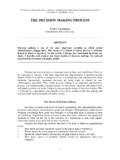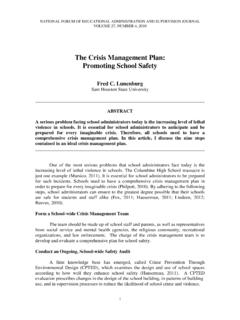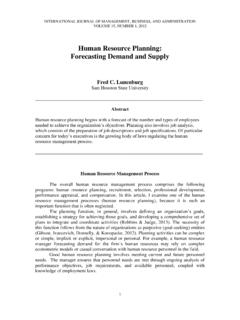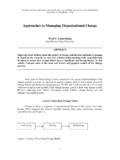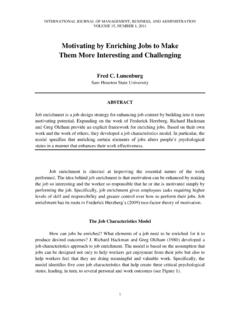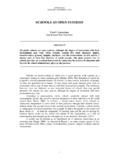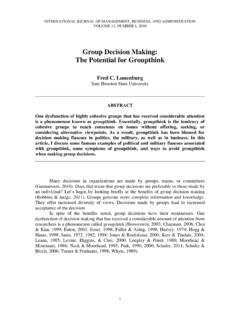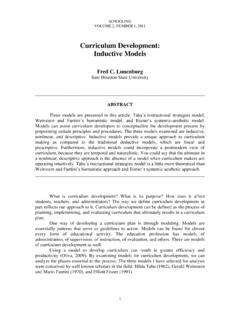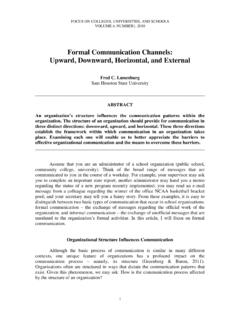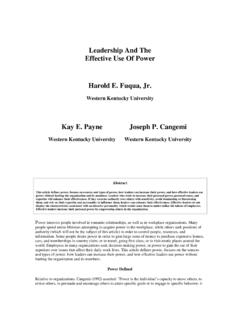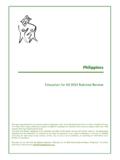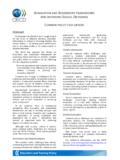Transcription of The Principal as Instructional Leader - National …
1 National FORUM OF educational AND SUPERVISION JOURNAL VOLUME 27, NUMBER 4, 2010 1 The Principal as Instructional Leader Fred C. Lunenburg Sam Houston State University ABSTRACT The Principal s primary responsibility is to promote the learning and success of all students. In this article, I discuss how school principals can accomplish this goal by focusing on learning; encouraging collaboration; analyzing results; providing support; and aligning curriculum, instruction, and assessment. Demands for greater accountability, especially appeals for the use of more outcome-based measures, requires the Principal to be instruction oriented. Are the students learning? If the students are not learning, what are we going to do about it? The focus on results; the focus on student achievement; the focus on students learning at high levels, can only happen if teaching and learning become the central focus of the school and the central focus of the Principal (Blankstein, 2010; Bulach, Lunenburg, & Potter, 2008).
2 How can principals help teachers to clarify Instructional goals and work collaboratively to improve teaching and learning to meet those goals? Principals need to help teachers shift their focus from what they are teaching to what students are learning. We cannot continue to accept the premise that I taught it; they just didn t learn it. The role of Instructional Leader helps the school to maintain a focus on why the school exists, and that is to help all students learn (Blase, Blase, & Phillips, 2010; Smylie, 2010). Shifting the focus of instruction from teaching to learning; forming collaborative structures and processes for faculty to work together to improve instruction; and ensuring that professional development is ongoing and focused toward school goals are among the key tasks that principals must perform to be effective Instructional leaders in a professional learning community (Lunenburg & Irby, 2006).
3 This will require districtwide leadership focused directly on learning. School principals can accomplish this by (1) focusing on learning, (2) encouraging collaboration, (3) using data to improve learning, (4) providing support, and (5) aligning curriculum, instruction, and assessment. Taken together, these five dimensions provide a compelling framework for accomplishing sustained districtwide success for all children (Fullan, 2010; Lunenburg, 2003; Marzano & Waters, 2010). National FORUM OF educational AND SUPERVISION JOURNAL 2_____ Focusing on Learning Principals can help shift the focus from teaching to learning if they insist that there are certain critical questions that are being considered in that school, and principals are in a key position to pose those questions (DuFour, DuFour, & Eaker, 2008). What do we want our students to know and be able to do?
4 The focus in a professional learning community is not on: Are you teaching, but are the students learning? How will you know if the students are learning? That points to student progress. How will we respond when students do not learn? What criteria will we use to evaluate student progress? How can we more effectively use the time and resources available to help students learn? How can we engage parents in helping our students learn? Have we established systematic collaboration as the norm in our school? These are the questions principals need to pose in order to shift the focus in schools from teaching to learning. Encouraging Collaboration A key task for principals is to create a collective expectation among teachers concerning student performance. That is, principals need to raise the collective sense of teachers about student learning (DuFour, DuFour, Eaker, Karhanek, 2010).
5 Then principals must work to ensure that teacher expectations are aligned with the school s Instructional goals. Furthermore, principals need to eliminate teacher isolation so that discussions about student learning become a collective mission of the school (Elmore, 2005; Senge, 2001, 2006). Principals must develop and sustain school structures and cultures that foster individual and group learning. That is, principals must stimulate an environment in which new information and practices are eagerly incorporated into the system. Teachers are more likely to pursue their group and individual learning when there are supportive conditions in the school, such as particularly effective leadership (English, 2008; Northouse, 2010). Schools where teachers collaborate in discussing issues related to student learning are more likely to be able to take advantage of internally and externally generated information.
6 Teachers can become willing recipients of research information if they are embedded in a setting where meaningful and sustained interaction with researchers occurs in an egalitarian context (Blankstein, Houston, & Cole, 2009). One popular collaboration structure is teacher teams. Schools are recognizing that teachers should be working together in teams as opposed to working individually in isolation in their classrooms. High performing teams will accomplish four different things (Smylie, 2010): (1) They will clarify exactly what students should know and be able to do as a result of each unit of instruction. We know that if teachers are clear on the intended results of instruction, they will be more effective. (2) They will then design curriculum and share Instructional strategies to achieve those outcomes. (3) They will develop valid assessment strategies that measure how well students are performing.
7 (4) Then they will analyze those results and work together to come up with new ideas for improving those results. Regular assessment and analysis of student learning are key parts of the team s process. FRED C. LUNENBURG _____3 Using Data to Improve Learning How can schools gauge their progress in achieving student learning? Three factors can increase a school s progress in achieving learning for all students (Blankstein, Houston, & Cole, 2010; Love, 2009). The primary factor is the availability of performance data connected to each student. Performance data need to be broken down by specific objectives and target levels in the school curriculum. Then the school is able to connect what is taught to what is learned. The curriculum goals should be clear enough to specify what each teacher should teach. And an assessment measure, aligned with the curriculum, will indicate what students have learned (Popham, 2010a, 2010b).
8 Also, teachers need access to longitudinal data on each student in their classroom. With such data, teachers are able to develop individual and small-group education plans to ensure mastery of areas of weakness from previous years while also moving students forward in the school curriculum. The second factor is the public nature of the assessment system. Annually, the school district should publish a matrix of schools and honor those schools that have performed at high levels. This provides role models for other schools to emulate. At the school and classroom levels, it provides a blueprint of those areas where teachers should focus their individual education plans (IEPs) and where grade levels or schools should focus the school s professional development plans. The public nature of the data from the accountability system makes clear where schools are. Data should be disaggregated by race/ethnicity, socioeconomic status, English language proficiency, and disability.
9 Performance of each subgroup of students on assessment measures makes the school community aware of which students are well served and which students are not well served by the school s curriculum and instruction. The third factor in gauging progress toward achieving student learning is the specifically targeted assistance provided to schools that are performing at low levels. Before the advent of accountability systems, it was not evident which schools and students needed help (Lunenburg & Ornstein, 2008). The first step is to target the schools in need of help based on student performance data. Each targeted school is paired with a team of principals, curriculum specialists/ Instructional coaches, and researchers to observe current practices; discuss student performance data with staff; and assist in the development and implementation of an improvement plan.
10 The targeted schools learn how to align their program of professional development to the weaknesses identified by the data. They learn how to develop an improvement plan to guide their activities and monitor the outcomes of the activities, all of which are designed to raise student performance levels. Next, once a team of teachers has worked together and identified students who are having difficulty, then the school faces the challenge of how they are going to respond to the students who are not learning (Murphy, 2010). The challenge is not simply re-teaching in the same way in which teachers taught before, but providing support for teachers to expand their repertoire of skills and providing support and time for students to get additional assistance they need in order to master those skills. When students are not learning, principals must insure that professional development programs are in place to National FORUM OF educational AND SUPERVISION JOURNAL 4_____ give additional support to teachers and intervention strategies are in place to give additional support to students (Joyce & Calhoun, 2010).
